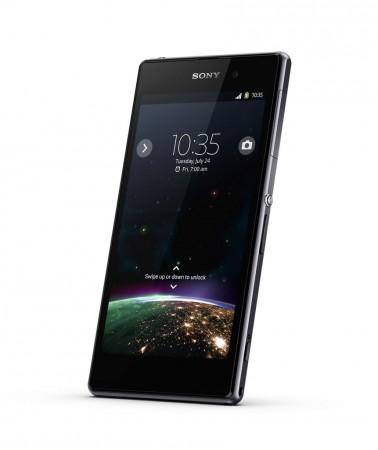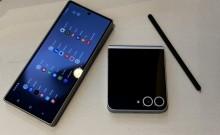
Japanese consumer electronics major, Sony, released a few weeks ago its new flagship Xperia Z1 smartphone in India, further intensifying the battle between high-end device makers.
Among the top Android smartphones, HTC One is rated as the number one, outdoing even Samsung Galaxy S4 thanks to its superior build quality and innovative camera features. Many touted the HTC smartphone as the iPhone, considered to be the king of all smartphones, among Android devices.
Now, with the release of the water-resistant Xperia Z1 with its 20.7-MP camera, HTC One has found itself a worthy competitor.
Here is a comparison of specifications between Sony Xperia Z1 and HTC One.
Display:
Sony Xperia Z1 flaunts a 5.0-inch full HD TRILUMINOS display boasting of 'X-Reality for Mobile' picture engine and is well protected by a shatter and scratch-resistant sheet. It has a pixel density of 441 ppi (pixels per inch).
On the other hand, HTC One sports a full HD (1920x1080p) Super LCD 3 screen having a staggering pixel density of 468 ppi, one of the highest display resolutions in the industry. It comes with Gorilla Glass 2 shield.
Processor, RAM and Storage:
In terms of power, Sony Xperia Z1 trumps HTC One thanks to its Qualcomm Snapdragon 800 series quad-core processor which can top a maximum CPU speed up to 2.26 GHz. It is paired with Adreno 330 graphics engine and 2GB RAM with 16GB inbuilt memory (expandable up to 64GB).
HTC One ships with a slightly older Qualcomm Snapdragon 600 series quad-core processor with a CPU speed of 1.7GHz. It also features Adreno 320 GPU, 2GB RAM and 32GB storage space.
Camera:
Both Sony Xperia Z1 and HTC One boasts of the industry's most innovative camera specification in a smartphone, giving Nokia's PureView camera technology a run for its money.
Xperia Z1 houses a stunning 20.7-megapixel camera with CMOS Exmor RS image sensor (f1/2.3-inch aperture) with Sony's exclusive patented camera technology, G-Lens (27 mm wide angle and bright f2.0 aperture) and BIONZ image processor, which are only found in expensive DSLR cameras.
To further enrich the camera specifications, Sony has included superior auto and manual options, time-shift burst mode (allows users to snap 61 pictures in two seconds), Sweep Panorama, Social Live (it lets users to broadcast live video on social platform like Facebook), Info-eye feature, AR Effect feature, which lets users put 'Augmented Reality' scenarios on to a picture to make short-video clips.
On the other hand, HTC One houses a splendid 2.0-UltraPixel rear camera (equivalent to 4.0-megapixel). It is one of the first smartphones in the industry to pack innovate lens inside it. The custom-build camera features a f/2.0 aperture lens which can absorb 300 percent more light than any other conventional smartphone camera sensors. The camera also features a dedicated imaging chip and multi-axis optical image stabilisation to ensure recording of smoother videos during the move or in stationary position.
HTC One and Sony Xperia Z1 each pack a 2.1-megapixel and 2.0-megapixel snappers on the front side. Both have the ability to record full HD (1920x1080p) resolution videos.
Mobile Operating System:
In this aspect, HTC One and Xperia Z1 score even points as they both run on the same Android platform. The Sony smartphone runs on the Android v4.2.2 Jelly Bean OS, whereas the HTC flagship ships with the Android v4.1.2 OS out-of-the-box (v4.3 upgrade is reportedly coming in October).
Price:
Sony Xperia Z1 is currently priced around ₹45,000, whereas the price of HTC One is hovering around ₹40,000.
With the Diwali festival around the corner, smartphone companies as well as private sellers are expected to offer discounts in the coming days.
Key specifications of Sony Xperia Z1 and HTC One:
|
Model |
Sony Xperia Z1 |
HTC One |
|
Display |
5.0-inch full HD TFT (1920x1080p) TRILUMINOS display boasting 'X-Reality for Mobile' picture engine. It is well protected by shatter and scratch resistant sheet. Pixel density: 441 ppi (pixels per inch) |
4.7-inch full HD (1920x1080p) Super LCD 3 display and comes with Corning Gorilla Glass 2 protective shield against sctraches. Pixel density : 468 ppi |
|
OS |
Android v4.2.2 Jelly Bean |
Android v4.1.2 Jelly Bean (v4.3 upgrade coming in October ) |
|
Processor |
Qualcomm Snapdragon 800 series quad-core processor with 2.2Ghz CPU speed |
Qualcomm Snapdragon 600 series quad-core processor with 1.7GHz CPU Speed |
|
GPU |
Adreno 330 |
Adreno 320 |
|
RAM |
2GB |
2GB |
|
Storage capacity |
16GB, memory can be expanded up to 64GB via microSD card |
32GB |
|
Camera |
Main: 20.7 -megapixel with CMOS Exmor RS camera sensor(f1/2.3-inch aperture) with Sony G-lens(27 mm wide angle and bright f2.0 aperture) and separate BIONZ image processor engine Front: 2.0-megapixel Exmor R camera with1080p video recording ability |
Main: 2.0 -UltraPixel camera (equivalent to 4.0-MP), 28 mm lens, LED Flash, BSI sensor, F2.0 aperture. Front: 2.1 -megapixel camera with HDR 1080p video recording ability |
|
Battery |
3000 mAh; Talk time: up to 14 hours Standby mode: 550 hours |
2,300 mAh (Li-Polymer); Talk time: up to 27 hours Standby mode: close to 500 hours |
|
Network |
3G |
3G |
|
Add-ons |
Water resistant and dust proof IP55/IP58 certifications, 3D and motion gaming, gesture control features, NFC, MHL, Wi-Fi, Bluetooth v4.0, micro-USB v2.0 |
Zero-gap Aluminum Unibody case, Bluetooth v4.0,Wi-Fi hot spot, Wi-Fi (802.11 a/b/g/n/ac), NFC (Near Field Communication), HTC BoomSound(front-facing stereo speakers) |
|
Dimensions |
144.4 x 73.9 x 8.5 mm |
137.4 x 68.2 x 9.3 mm |
|
Weight |
169 g |
143 g |
|
Colours |
White, Purple and Black |
Silver and Black (in India) |
|
Price |
Around ₹44,990/- |
Around ₹40,600/- |








![India Auto Roundup: Maruti Suzuki, Mahindra have exciting launches in November [details here]](https://data1.ibtimes.co.in/en/full/805520/india-auto-roundup-maruti-suzuki-mahindra-have-exciting-launches-november-details-here.jpg?w=220&h=138)








